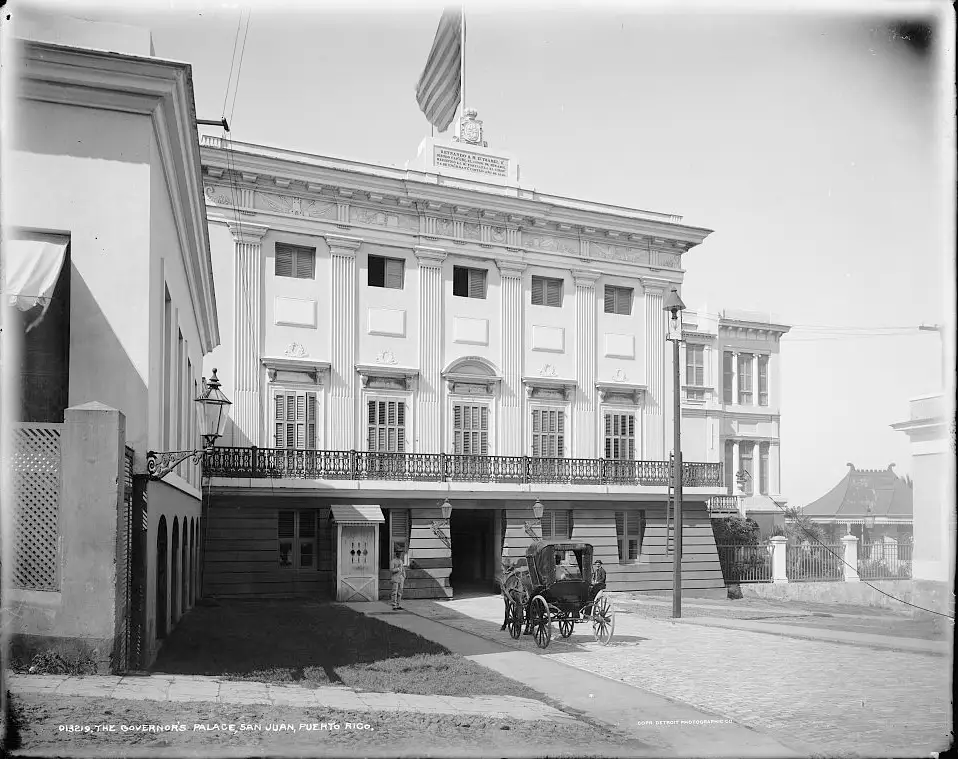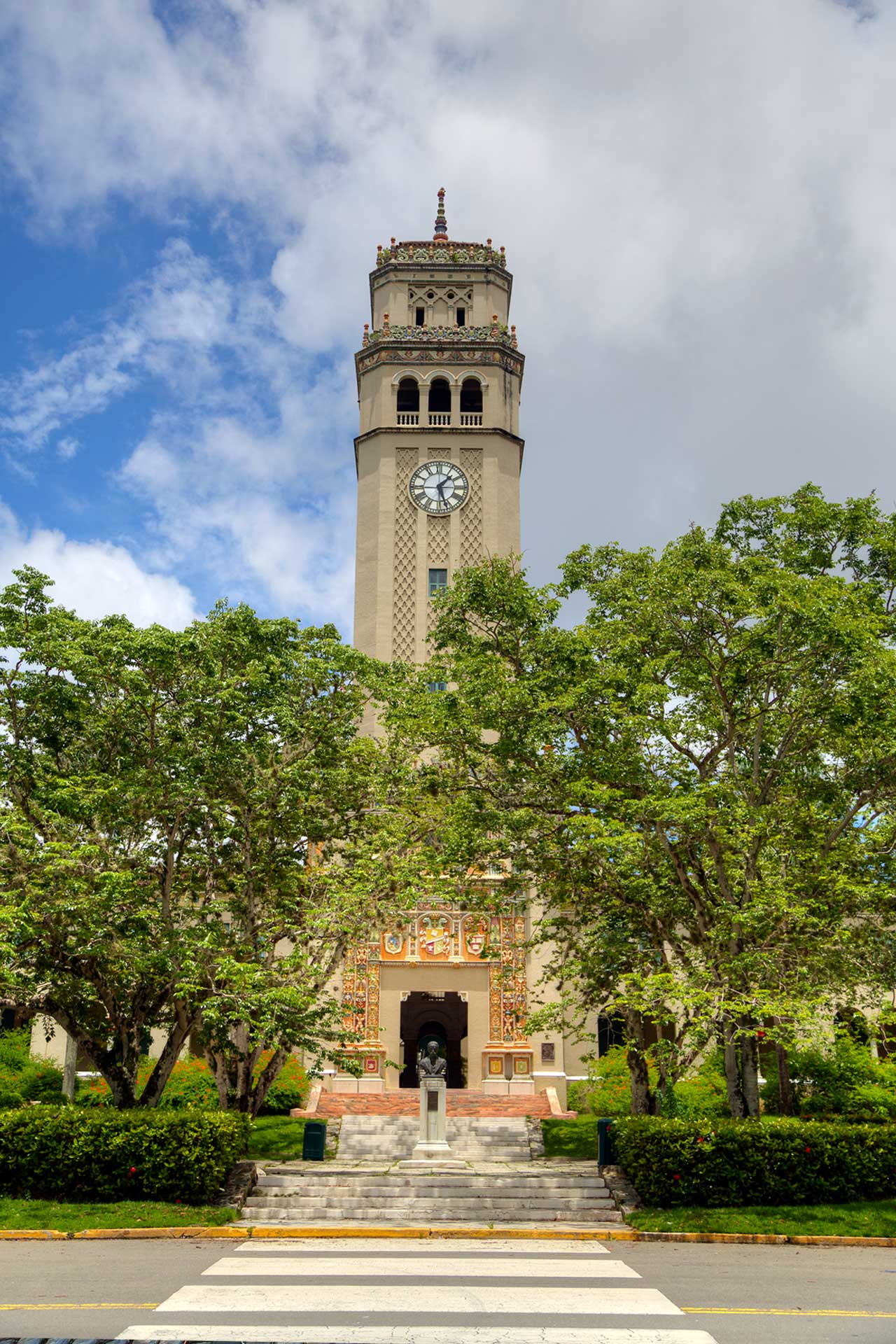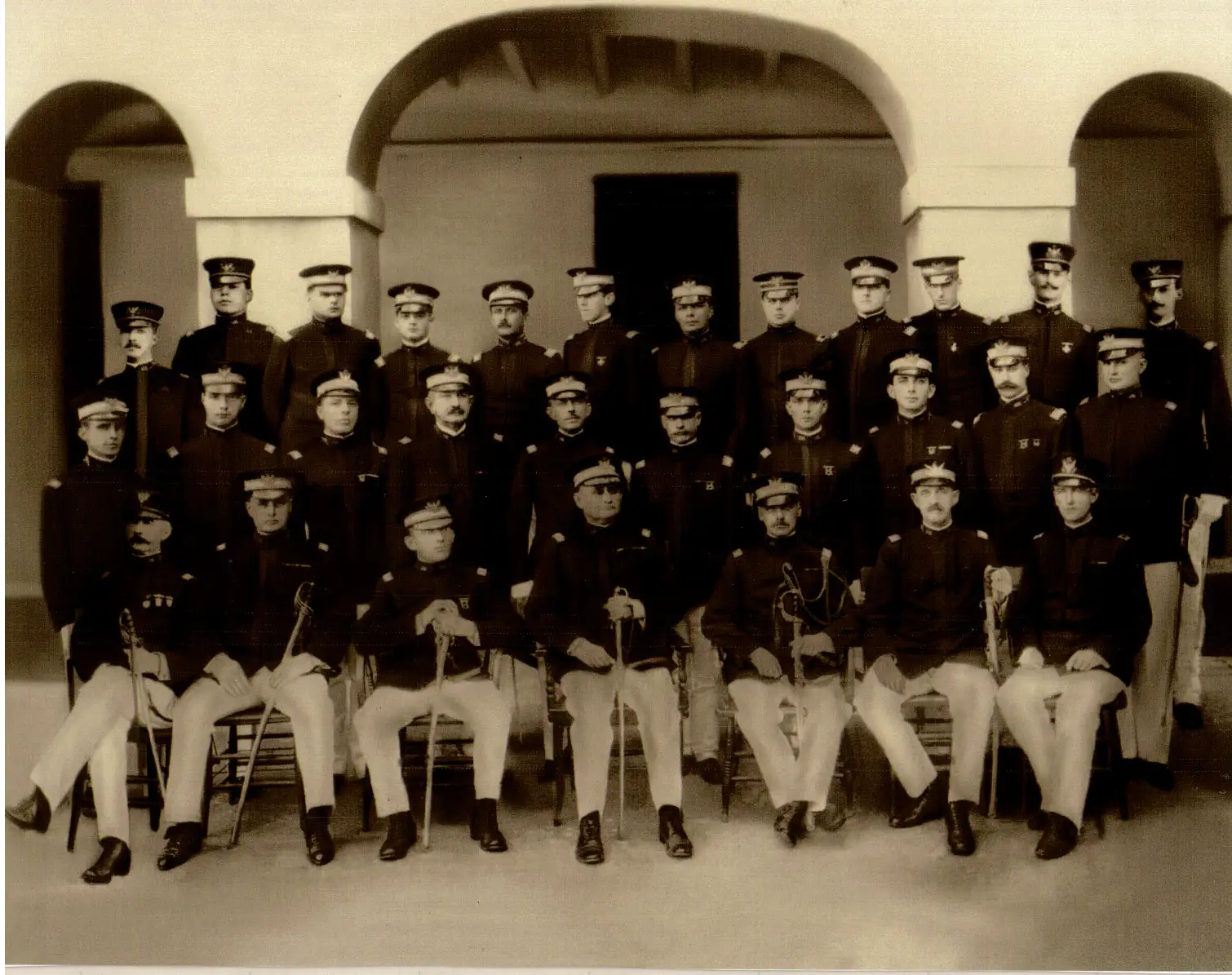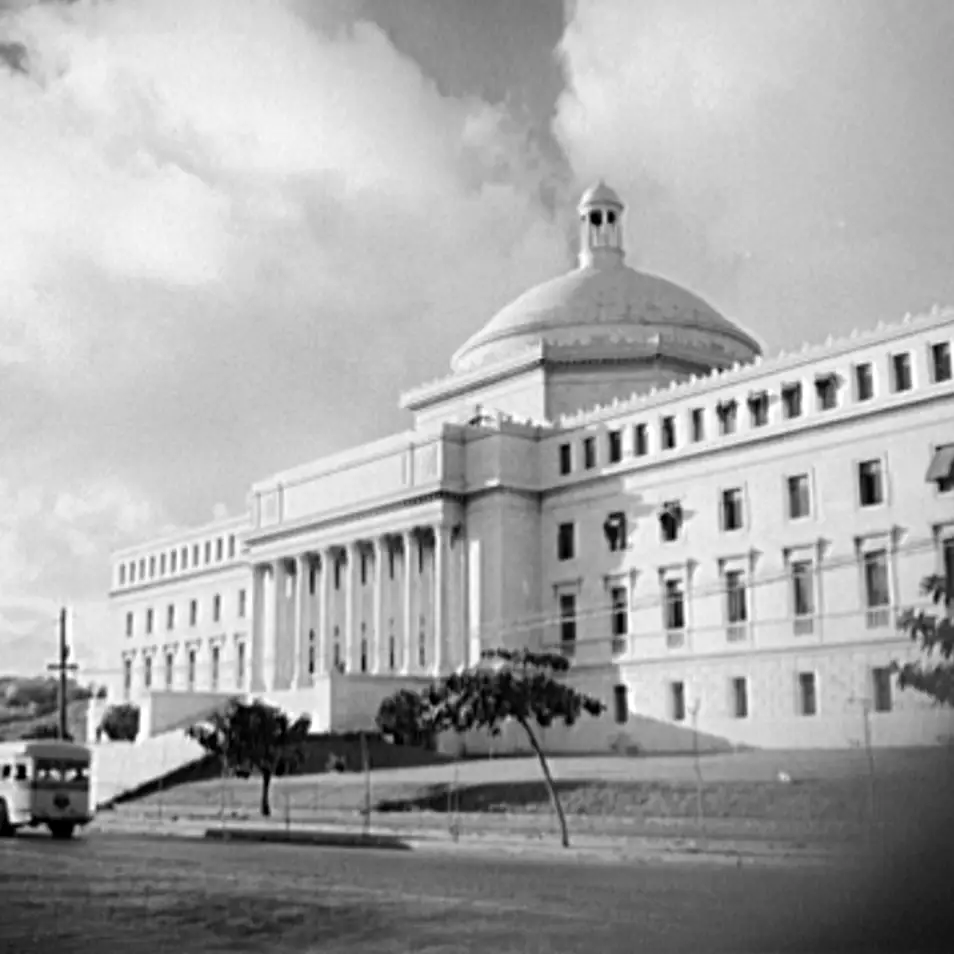Puerto Rico's History
1900 - 19491900
The island was surrendered to the United States military authority.
On April 2, the Foraker Law, officially the Organic Act of 1900, is approved, establishing civil government and free commerce between the island and United States. The law was introduced into Congress by senator Joseph B. Foraker. Puerto Rico became U.S. first unincorporated territory. The new government had an American governor, with 5 Puerto Rican Cabinet members.
On March 4th, Federico Degetau takes office in Washington as the first Resident Commissioner from Puerto Rico.
On March 19, President McKinley asserts the need for free trade with Puerto Rico.
On May 1, the first civil governor (Charles H. Allen) of the island under the Foraker Act was inaugurated.
On June 5, President McKinley named an Executive Cabinet under Gov. Charles H. Allen that included five Puerto Rican members--José Celso Barbosa, Rosendo Matienzo Cintrón, José de Diego, Manuel Camuñas and Andrés Crosas, and six U.S members--William H. Hunt, Secretary; J.H. Hollander, Treasurer; J.R. Garrison, Auditor; W.B. Eliot, Interiors; James A. Harlan, Attorney General; and Dr. M.G. Brumbaugh, Secretary of Education.
The Department of Education was formed with Dr. M. G. Braumbaugh (later governor of Pennsylvania) the first Commissioner of Education. The method of of teaching was entirely in English with Spanish treated as a special subject.
The Partido Federal (Federal Party) is founded. The party campaigns for Puerto Rico to become one of the States in the United States.
On July 4th, Beeckman Winthrop became the governor of Puerto Rico and served until 1907.
On November 6, the first elections under Foraker Act were celebrated (registered voters 123,140).
On December 3, the first Legislative Assembly which met.
On December 11, during a visit to Puerto Rico, U.S. President Theodore Roosevelt addressed the Puerto Rican Congress and recommended that Puerto Ricans become United States citizens.
1901

Detroit Publishing Co.
The Hollander Law was approved, named after Puerto Rico's US-appointed Treasurer, Jacob Hollander. The law impose a %1 tax on land, it exempted lands priced below $100 and thus fell squarely on middle- and high-income landowners. The implementation of this law coincided with an artificial devaluation of the Puerto Rican Peso by US authorities, each peso valued at 60 American cents: a currency devaluation of 40%.
On March 4, Federico Degetau takes office in Washington as the first Resident Commissioner from Puerto Rico.
On June 30, the Porto Rico Provisional Regiment of Infantry was organized to enable Puerto Ricans who lived in the island to serve in the military, while Puerto Ricans who resided on the mainland served in regular units of one of the following branches of the United States military, the United States Marine Corps, Army or the Navy. The United States implemented the policy of military segregated units in Puerto Rico. Puerto Ricans of African descent were assigned to segregated all-black units and were subject to the discrimination which was rampant in the U.S. in those days, such as the 375th Regiment.
1902
The Porto Rico Telephone Company was inaugurated.
Cuba declares independence; United States declares Puerto Rico a territory.
On November 4, the second elections under Foraker Act were celebrated (registered voters 158,924).
The Official Languages Act (under the Foraker Act) was instituted which declared that in all insular governmental departments, courts, and public offices, English was to be regarded as co-official with Spanish, and when necessary, translations and interpretations from one language to the other would be made so that all parties could understand the proceedings.
1903

On January 17, U.S. officially designates Luquillo Forest Reserve the only tropical rain forest in the National Forest System, the first created by President Theodore Roosevelt.
University of Puerto Rico is founded.
Roosevelt signed an executive order to surrender the Culebra to Navy Control.
1904
Luis Muñoz Rivera and José de Diego founded the Partido Unionista de Puerto Rico (Unionist Party of Puerto Rico) to fight against the colonial government established under the Foraker Act (reformation of the Federal Party).
On July 4, Beeckman Winthrop became the governor of Puerto Rico and served until 1907.
First universal suffrage was established, men over 21 years old were allow to participated.
Camp Las Casas was established in Santurce under the command of Lt. Colonel Orval P. Townshend. Two battalions of the former Porto Rico Provisional Regiment of Infantry was assigned to the camp.

(Puerto Rico National Guard)
1905
On March 9, a law establishing the official coat of arms was signed. The original coat of arms was granted by the Spanish Crown in 1511.
1906
The Federacion Libre de Trabajadores (Free Federation of Puerto Rican) is founded, which was affiliated with the American Federation of Labor. Led by Santiago Iglesias, among others.
On November 6, President Theodore Roosevelt leaves Washington D.C. for a 17 day trip to Panama and Puerto Rico, becoming the first president to make an official visit outside of the U.S.
On December 11, during a visit to Puerto Rico, U.S. President Theodore Roosevelt addressed the Puerto Rican Congress and recommended that Puerto Ricans become United States citizens.
1908
Driving licenses began to be issued.
The first motion picture projector was brought to the island. It is used in a tent theater called "Cine Puerto Rico".
1909
The Olmsted Amendment to the Foraker Act was passed by both houses of Congress, this act placed the supervision of Puerto Rican affairs in the jurisdiction of an executive department to be designated by the president. The legislation was a response to a governmental crisis in Puerto Rico in early 1909.
1910
The U.S. Census Bureau reported that the island's total population was counted as 1,118,012, an increase of 17%. This was the second population census held in Puerto Rico by the U.S. Census Bureau.
1911
The College of Agriculture and Mechanic Arts was founded in Mayag¨uez. Today it is known as the University of Puerto Rico - Mayagüez Campus (UPRM), considered the leading science and engineering institution in the Caribbean.
1912
On June 29, The Inter American University was established by the United Presbyterian Church. The IAU is a private, nonprofit institution. The system includes schools of law and optometry.
Rosendo Matienzo Cintrón, Manuel Zeno Gandía, Luis Llorens Torres, Eugenio Benítez Castaño, and Pedro Franceschi founded the Partido Independentista (Independence Party) which was the first party in the history of the island to exclusively want Puerto Rican independence. Though short-lived, it established a precedent for future organizations with similar ideologies.
1914
The first Puerto Rican officers are assigned to the Executive Cabinet, allowing islanders a majority. The officers were Martin Travieso, Secretary, and Manuel V. Domenech, Commissioner of Interiors.
The first postal savings bank was opened in San Juan.
The first public coin telephone was installed, operator-assited calls
and the charge for a call was 5 cents. (The first public coin telephone in the
world was installed by William Gray in Hartford, Conn in 1889.)
1915
A delegation from Puerto Rico, accompanied by the Gov. Arthur Yager, traveled to Washington in order to ask Congress to grant the island more autonomy.
1916
On December 5, the Jones Act is approved.
On August 22, a hurricane strikes the island.
1917
On March 2, President Woodrow Wilson signed the Jones-Shafroth Act, best known as Jones Act. With this law:
- Puerto Rico became a territory of the United States ("organized but unincorporated,")
- A bill of rights was created.
- Separated the three governmental powers into: the legislative, executive and judicial branches.
- United States granted Puerto Ricans U.S. statutory citizenship, which means
that Puerto Ricans were granted citizenship by act of Congress, not by the
Constitution and citizenship is therefore not guaranteed by it. (The Puerto
Rican citizenship ceased, it was not until 1927 that it was reestablished for
residency purposes only.)
As citizens, they were now allowed to join the army, only 300 rejected the citizenship and many others refused to join the army. During World War I, over 18,000 Puerto Ricans served. - Established that elections were to be celebrated every four years.
- English is decreed the official language of Puerto Rico.
On the other hand, the Foraker Act still determined economic and fiscal aspects of government.
On April 6, the U.S. joined its allies--Britain, France, and Russia--to fight in World War I.
On May 18, U.S. President Woodrow Wilson signs compulsory military service act into law. The act required all men in the U.S. between the ages of 18 and 32 to register for military service, excluding the territories of Alaska, Hawaii, and Puerto Rico.
On May 20, the Puerto Rican Legislature extends the draft to the island. 20,000 islanders are drafted into World War I.
On July 6, the first elections under Jones Act were celebrated.
The Organic Act was approved. This gave the island a legislature (19 senators, 39 representatives) elected freely by the Puerto Rican people.
1918
"El Imparcial" newspaper is founded.
On October 11, an earthquake occurred, with an approximate magnitude of
7.5 on the Richter scale
![]() and was accompanied by a
tsunami
and was accompanied by a
tsunami
![]() which got up to 6 meters
(19.5 feet) high. The epicenter was located northwest of Aguadilla in the
Mona Canyon (between Puerto Rico and the Dominican Republic), causing great
damage and loss of life in Mayagüez, and lesser damage along the west
coast. The tremors continued for several weeks.
which got up to 6 meters
(19.5 feet) high. The epicenter was located northwest of Aguadilla in the
Mona Canyon (between Puerto Rico and the Dominican Republic), causing great
damage and loss of life in Mayagüez, and lesser damage along the west
coast. The tremors continued for several weeks.
1919
The Puerto Rican National Guard is founded, by MG Luis Esteves who was the first Puerto Rican Graduate of West Point.
"El Mundo" newspaper is founded.
The U.S. Army Reserve Officers Training Corps (ROTC) program was created. ROTC was originally compulsory for university students, but became voluntary after 1960.
150 die at the Teatro Yaguez fire.
1920
On June, the Partido Socialista Puertorriqueño (Socialist Puerto Rican Party) is founded, led by Santiago Iglesias Pantín.
Santiago Iglesias Pantín was elected senator, becoming the first Socialist senator, and marking the rise of the Socialist Party as a major party in insular politics.
1921
Emmet Montgomery Reilly was appointed governor of Puerto Rico. (1921-1923) Montgomery is one of the most hated governors.
On June 3, during President Harding's term, the Johnson Act was passed. The act establishes immigration quotas, restricted the immigration of Europeans to the United States. The quota system was based on 3% of existing foreign-born nationality's population in US. As a result, the availability of jobs for Puerto Ricans choosing to migrate to the United States increased.
1922
In the case of Balzac v. Porto Rico (258 U.S. 308) the U.S. Supreme Court declared that Puerto Rico was a territory rather than a part of the Union. The decision stated that the U.S. constitution did not apply in Puerto Rico.
On September 17, the Partido Nacionalista de Puerto Rico (Puerto Rican Nationalist Party) is founded.
On December 3, the first radio station WKAQ was inaugurated.
1925
The construction on the Capitol Building began.
Fort Buchanan was established in 1925, originally named Fort Miles.
1926
On July 23-27, a hurricane strikes the island.
1928
On September 13, Hurricane Saint Phillip II ("San Felipe II") strikes the island. Three hundred people were killed.
Charles Lindbergh visited the island in his plane Spirit of St. Louis.
1929
With the Wall Street stock-market crash of 1929 precipitated the Great Depression, the worst economic downturn in the history of the United States. The depression had devastating effects on the island, creating widespread hunger and unemployment. Many banks couldn't continue to operate. Farmers fell into bankruptcy. The Depression lasted over a decade.
On January 9, Pan Am Airline started the first flights to Miami.
The Air Mail postal service was inaugurated.
Women were given the right to vote, but only to women who knew how to read and write.
1930
Pedro Albizu Campos was elected president of the Nationalist Party.
1931
On September 10-16, Hurricane Saint Nicholas strikes the island.
1932
On May 17, the Congress of United States approved a law to change back the name of the island Porto Rico, to its original name, Puerto Rico.
On September 30, Hurricane San Ciprián strikes the island. Two hundred people were killed, a thousand injured, and property damage reached $40,000,000.
1933
Blanton Winship was appointed Governor of Puerto Rico, Elisha Francis Riggs Chief of Police, and Robert A. Cooper Judge of the Tribunal of the United States in Puerto Rico.
The program for economic assistance known as Puerto Rican Emergency Relief Administration (PRERA) begins to be implemented.
Sixto Escobar became the first Puerto Rican to win a boxing championship of the National Boxing Association.
On May 9, cockfighting was legalized in Puerto Rico.
1934
Franklin D. Roosevelt visited the island.
Commissioner of Education José Padín agreed to adopt Spanish as the language of instruction in the elementary grades, up to grade eight. In subsequent grades, including higher education, English would continue as the language of instruction.
1935
On May 28, President Franklin D. Roosevelt created the Puerto Rican Reconstruction Administration (PRRA), which provided for agricultural development, public works, and electrification of the island.
The Sixto Escobar Stadium was inaugurated.
1936
On February 23, Puerto Rican Nationalists Hiram Rosado and Elias Beauchamp, in retaliation for the University Massacre ("Masacre of Rio Piedras"), kill Police Chief Riggs in San Juan. They are captured and killed in the police headquarters of Old San Juan.
On July 31, Pedro Albizu Campos, Juan Antonio Corretjer, Clemente Soto Vélez and other Nationalists sentenced to 6-10 years in federal prison.
Women given full suffrage.
Bacardi y Compañía was established by the Bacardi family in Puerta de Tierra.
1937
At the beginning of Nacionalista de Puerto Rico Party parade, in Ponce, occurred as called "Masacre de Ponce" were 20 people are killed and 100 people are wounded.
Pedro Albizu Campos and other Nationalists are transferred out of Puerto Rico to serve time in Atlanta, Georgia.
The Mercedita airport in Ponce started operations.
President Franklin Roosevelt proclaimed every October 12 as Christopher Columbus Day.
1938

By Edwin Rosskan
The Partido Popular Democratico (Democratic Popular Party) was founded, under the leadership of Luis Muñoz Marín, which adopted the slogan "Bread, Land, and Liberty." The party favored independence for the country in its initial stages.
The Cervecería India was inaugurated.
1939
The U.S. Navy purchased 27,000 acres of land on Vieques Island.
World War II was the biggest and deadliest war in history, involving more than 30 countries. Sparked by the 1939 Nazi invasion of Poland, the war dragged on for six years until the Allies defeated Nazi Germany and Japan in 1945.
1940
With the 1940 U.S. Nationality Act, which became effective January 13, 1941, ratified by the Nationality Law in 1952, the Congress amended the statute on naturalization, expanding the applicability of the jus soli rule to Puerto Rico. Under this Act, all persons born in Puerto Rico after that date are considered U.S. citizens and, therefore, their U.S. citizenship is protected under the 14th Amendment of the U.S. Constitution. (In 1917, U.S. citizenship granted to Puerto Ricans was a naturalized legislative or statutory citizenship (Congress can revoke statutory citizenship under certain conditions).)
Camp Santiago in Salinas was established as a Puerto Rican National Guard training facility.
1941
United States began to establish military bases in the islands of Culebra and Vieques. The Roosevelt Roads Naval Station is one of the largest naval facilities in the world, covering about 32,000 acres and encompassing three harbors and two-thirds of the island of Vieques.
President Franklin D. Roosevelt appointed Rexford Guy Tugwell as governor of Puerto Rico (1941-1946).
The Ponce Cement Corporation was founded and started operations in Ponce.
1942
The Banco Gubernamental de Fomento was founded.
Puerto Rico Industrial Development Company was established.
On May 11, the 188 Law was signed, the law regulates a industrial development program, better known as the "Manos a la Obra" (Hands to work), under the direction of pharmacist Teodoro Moscoso and the Industrial Company of the Development. ICD became the main promoter of the economic development in Puerto Rico.
Hiram Bithorn (Chicago Cubs) became the first Puerto Rican to play in the Major Leagues.
1943
On April 2, U.S. Senator Tydings introduces bill to Congress calling for independence for Puerto Rico.
The U.S. Postal Service issued an stamp to commemorate the 450th anniversary of Columbus' landing on Puerto Rico.
During World War II, the Army's 65th Infantry Regiment, a segregated Hispanic unit made up primarily of Puerto Ricans, nicknamed "Borinqueneers" (special designation), was sent to Panama to protect the Pacific in 1943, and by 1944, was sent to France. They participated in the battles of Naples-Fogis, Rome-Arno, central Europe and Rhineland. The regiment had 23 soldiers killed in action.
During that time, it is estimated by the Department of Defense that 65,034 Puerto Ricans served in the U.S. military.
1945
Puerto Ricans began to emigrate to United States, looking for job and better economic situation.
1946
On July 7, Pan American Airlines starts non-stop flights to New York.
On July 21, President Harry Truman designates native born Jesús T. Piñero governor, becoming the first Puerto Rican to govern the island.
The Partido Independentista Puertorriqueño (Puerto Rican Independence Party) was founded.
The Caribbean National Forest, commonly known as "El Yunque" was designated an insular wildlife refuge.
A bill was passed ordering "the exclusive use of the Spanish language for teaching in all public schools."
1947
On August 5th, United States Congress passed the Elective Governors Act, allowing Puerto Ricans to elect their own governor, President Harry Truman signed the act.
More than 20 airlines provide service between San Juan, Puerto Rico, and Miami, and San Juan and New York.
1948
Pedro Albizu Campos was invited to speak at the University of Puerto Rico in Rio Piedras by its students. The Rector Jaime Benitez is against the invitation. A strike is held in the University of Puerto Rico, which lead to violent police repression.
The first Olympic participation of Puerto Rico took place in London and boxer Juan Evangelista Venegas brings home Puerto Rico's first Olympic medal, a bronze one.
On June 10, the Puerto Rican legislature approved the infamous Law 53, known as "La Ley de la Mordaza" (Gag Law). The law made it illegal to display a Puerto Rican flag, to sing a patriotic tune, to talk of independence, and of course to fight for the liberation of the island. It was also known as "the Little Smith Act" because it was patterned after a similar fascist law passed for the mainland.
On August 15, gambling was legalized in Puerto Rico.
Luis Olmo (Los Angeles Dodgers) became the first Puerto Rican to play in a World Series game and the first one to hit a Home Run and to get three hits, in the same game.
On November 2, the first popular elections for Governor of Puerto Rico take place. Luis Muñoz Marín was elected, with 61.2% of the vote.
Luis Muñoz Marin campaigned for economic reforms and structural changes in the political relationship between the U.S. and islanders. Marin and other political leaders considered agricultural countries to be underdeveloped and industrial countries developed, manufacturing was seen as the means by which Puerto Rico could develop economically. As a consequence the government launched an industrialization program known as "Operation Bootstrap." Under this program the island was to become industrialized by providing labor locally, inviting investment of external capital, importing the raw materials, and exporting the finished products to the U.S. market.
The Statehood Republican Party was founded.
The Catholic University of Puerto Rico was founded. It has faculties of arts and humanities, science, education, business, and law.
Puerto Rico sends the first delegation to the Olympics.
1949
Caribe Hilton Hotel was inaugurated. (Fomento invested more than $7 million dollars.) Hilton becomes the first international hotel chain with the opening of the Caribe Hilton in San Juan.
San Juan National Historic Site was established.
Other Resources
- Act Jones, Carta Orgánica de 1917
- Jus Soli Citizenship
- Ley Foraker del 1900
- Tax All the Fat People: The History of Taxes in Puerto Rico
- U.S. Tax Imperialism in Puerto Rico



